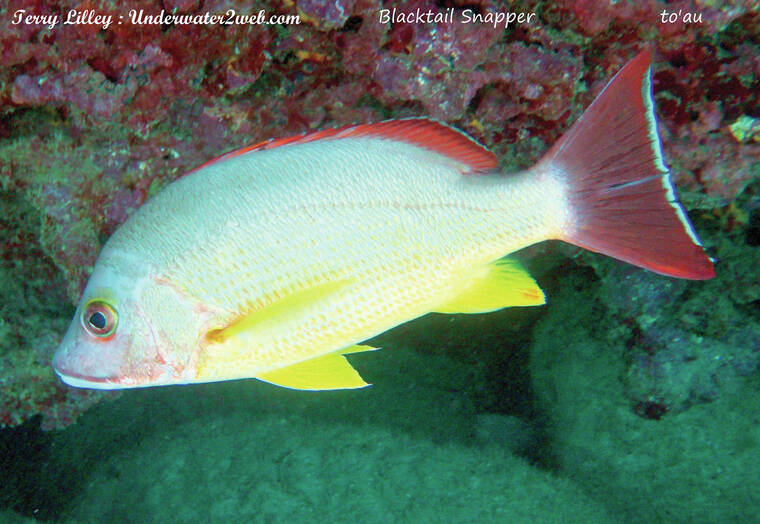To‘au is one of the most-common fish species in the Hawaiian islands, and almost every diver will see them near the rocky reef during a dive from 10 feet deep to about 40 feet deep. This fish grows to be about a foot long, and during the day hangs out in caves or near the bottom, often in large schools. They are more active at night when they are out feeding, and the black-tail snappers are known to move from reef to reef, often migrating due to the season of large surf.
To‘au is one of the most-common fish species in the Hawaiian islands, and almost every diver will see them near the rocky reef during a dive from 10 feet deep to about 40 feet deep. This fish grows to be about a foot long, and during the day hangs out in caves or near the bottom, often in large schools. They are more active at night when they are out feeding, and the black-tail snappers are known to move from reef to reef, often migrating due to the season of large surf.
To‘au is not their Hawaiian name, but it is their Tahitian name, as this fish species was introduced in 1956 from French Polynesia into Kane‘ohe Bay in O‘ahu by the state. This turned out to be a huge mistake, because the fish now has taken over the reef habitat all throughout the main Hawaiian islands and has out competed the native Hawaiian fish like the aweoweo and kumu.
Forty years ago, fishermen at Makua Reef in Kaua‘i (Tunnels) could always catch the abundant native red fish that lived in the lava tubes off the edge of the reef, but now the to‘au have taken over that habitat. I did a scuba dive at Makua Thursday and counted over 100 to‘au and not one aweoweo or kumu!
As a general rule, transplanting nonnative marine life from one country to another is not good because that new species is likely to change the entire marine ecosystem that took many thousands of years to evolve. The black-tail snapper in Mo‘orea is very common and the primary fish that is caught to feed the community.
In Bora Bora, if you go to a restaurant and have fresh-caught snapper you usually will be served to‘au. The fish is really good to eat and a very sustainable fish to feed the community, but when it was introduced into Kane‘ohe Bay the fish that were caught for food often carried ciguatera fish poisoning, which made the local fishermen sick! Scientific studies over the past 20 years have shown that ciguatera comes from an algae species that grows in Kane‘ohe Bay, but the to‘au caught from other parts of Hawai‘i very seldom carry any ciguatera and are good to eat. The information about the toxic, black-tailed snappers from Kane‘ohe spread all over Hawai‘i, and people stopped catching them, and now they have taken over the reef system.
Since I spear fish, I often spear and eat to‘au to try and reduce their numbers to give the native fish a chance to come back, but I am always cautious about when I eat the fish. Ciguatera is a neurotoxin, and it will make you sick within three to five hours after eating it. I always just eat a very tiny piece of the fish when I catch it and wait until the next day to eat the whole fish or give it away. Eating a tiny piece of fish containing ciguatera will only cause a mild stomach ache for a while so you will know not to eat the whole fish, which could make you go to the hospital.
You can see to‘au in action in my underwater educational movie “The World’s Guide To Hawaiian Reef Fish” up on my web at underwater2web.com. And, by the way, the black-tail snapper does not have a black tail! Its tail is actually purple, but I am sure that 3,000 years ago when it was named, fishermen did not have scuba tanks, masks and dive lights like I do, so the fish looked like it had a black tail when you look down on it from a cliff up above the waves. When you catch the fish and take it out of the water its purple tail turns black!
•••
Terry Lilley is a marine biologist living in Hanalei and co-founder of Reef Guardians Hawai‘i, a nonprofit on a mission to provide education and resources to protect the coral reef. To donate to Reef Guardians Hawai‘i go to reefguardianshawaii.org.







Please correct the attribution in these articles. Terry Lilley is not a marine biologist. He at best is a photographer.
Much RESPECT to Terry Lilly for writing about the invasive species and natives of our Hawai’ian waters.
The photos are outstanding and let’s hope our Keiki continue in the Reef Guardianship that Kumu Terry founded, to get their degrees and scholarships to further the process of protecting our Natural resources.